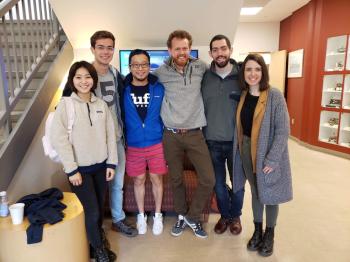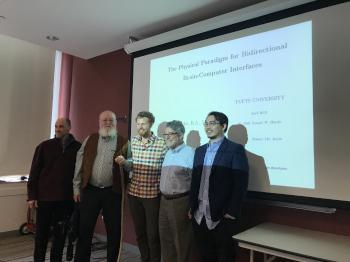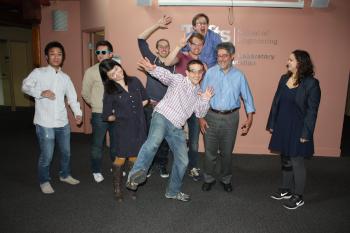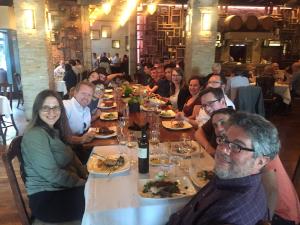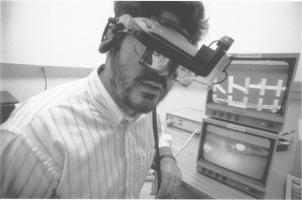Robert Jacob
# Robert J.K. Jacob
Dept. of Computer Science
Tufts University
Halligan Hall
161 College Avenue
Medford, MA 02155 U.S.A.
Email: jacob@cs.tufts.edu
Phone: 617-627-2225
Fax: 617-627-2227
# Background
Robert Jacob is a Professor of Computer Science at Tufts University, where his research interests are new interaction modes and techniques and user interface software; his current work focuses on implicit brain-computer interfaces. He has been a visiting professor at the University College London Interaction Centre, Universite Paris-Sud, and the MIT Media Laboratory. Before coming to Tufts, he was in the Human-Computer Interaction Lab at the Naval Research Laboratory. He received his Ph.D. from Johns Hopkins University, and he is a member of the editorial board for the journal Human-Computer Interaction and a founding member for ACM Transactions on Computer-Human Interaction. He has served as Vice-President of ACM SIGCHI, Papers Co-Chair of the CHI and UIST conferences, and General Co-Chair of UIST and TEI. He was elected as a member of the ACM CHI Academy in 2007 and as an ACM Fellow in 2016.
# Current Research: Implicit Brain-Computer Interfaces
The current focus in my research group is on a new generation of "implicit" brain-computer interfaces. They allow a computer to obtain and act on auxiliary inputs from its user without requiring explicit user action or attention. Brain-computer interaction has made dramatic progress, but its main application to date has been for physically disabled users. Our work in real-time measurement and machine learning classification of functional near infrared spectroscopy (fNIRS) brain data is allows to create, use, and study new kinds of implicit user interfaces based on brain measurement.
We are using brain input as a way to obtain more information about the user and their context in an effortless and direct way from their brain activity. We then use it to adapt the user interface in real time. We are creating and studying these new user interfaces, with emphasis on domains where we can measure their efficacy.
We are now also broadening this work to include other forms of lightweight, passive, real-time adaptive implicit interaction, based on physiological or other measurements. Our focus continues to be on the design of subtle and effective implicit interfaces that make judicious use of the measurements we can obtain.
[General article] (opens new window)
[Overview chapter] (opens new window)
[More papers] (opens new window)



# Papers, Talks, News
- Papers (opens new window) with links to electronic versions of recent ones
- Talks and other presentations (opens new window)
- Professional activities (opens new window)
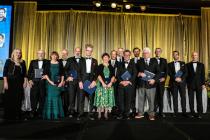
- Inducted as ACM Fellow (opens new window) 2016
- Gave opening keynote at First Neuroadaptive Technology Conference NAT'17 (opens new window), Berlin, 2017
- CHI 2016 paper (opens new window) on brain-computer interaction for music learning by Beste Yuksel et al. received Best Paper Award.
- Beste Yuksel's research on music learning reported in New Scientist (opens new window)
- IEEE Computer Special Issue on Physiological Computing, with Erin Solovey as guest co-editor, published October 2015 [Editors' introducton] (opens new window) [Contents] (opens new window) [Audio interview] (opens new window)
- Research featured in the Boston Globe (opens new window) (March 3, 2014), The Times (opens new window) (London), New York Post (opens new window), and elsewhere.
- Video and article about our research featured in Tufts Now (opens new window), also on WBUR's Radio Boston (opens new window) and CCTV America (opens new window)
- CHI 2014 paper (opens new window) on brain-computer interaction by Dan Afergan et al. received Best Paper Honorable Mention Award.
- Dan Afergan's research on brain-computer interfaces reported in New Scientist (opens new window)
- Evan Peck's research on brain-computer interfaces reported in New Scientist (opens new window), ACM Tech News (opens new window), and Discovery News (opens new window).
- CHI 2012 paper (opens new window) on brain-computer interaction by Erin Solovey et al. received Best Paper Honorable Mention Award. This work was also covered by MIT Technology Review (opens new window), extremetech.com (opens new window), and many other places (opens new window).
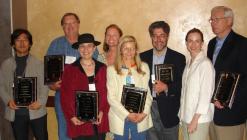
- Comment (opens new window) on future iPads in Huffington Post
- Comment (opens new window) on TV remote controls
- Still more comments, on the Spark radio show on CBC [podcast; segment starts around 0:06] (opens new window) [MP3, 53MB] (opens new window)
- Some comments (opens new window) on the legacy of Steve Jobs
- Mike Horn's work on tangible programming languages for children, at the Boston Museum of Science, reported on NECN TV
- Computerworld article [link] (opens new window) discusses Reality-Based Interaction (opens new window)
- Elected to ACM CHI Academy (opens new window) 2007 (Photo courtesy of Ben Shneiderman)
# Some Previous Research Projects
| Image | Project |
|---|---|
 | Reality-based Interaction: Understanding the Next Generation of User Interfaces [project] (opens new window) [CHI paper] (opens new window) [CHI workshop] (opens new window) |
 | Tangible Programming for children [Michael Horn] (opens new window) [project] (opens new window) [Robert Park] (opens new window) at Boston Museum of Science |
 | TUIMS: Tangible User Interface Management System [Orit Shaer] (opens new window) [paper] (opens new window) |
# Courses
# Fall 2020
- COMP 86 (opens new window) Object-Oriented Programming for Graphical User Interfaces
# Spring 2021
- COMP 171 (opens new window) Human-Computer Interaction
# Ph.D. Alumni
- Sam Hincks (opens new window), Spatial musician
- Beste Yuksel (opens new window), University of San Francisco
- Dan Afergan (opens new window), Google Inc.
- Evan Peck (opens new window), Bucknell University
- Erin Solovey (opens new window), Worcester Polytechnic Institute
- Audrey Girouard (opens new window), Carleton University
- Leanne Hirshfield (opens new window), University of Colorado Boulder
- Michael Horn (opens new window), Northwestern University
- Michael Poor (opens new window), Baylor University
- Orit Shaer (opens new window), Wellesley College
- Georgios Christou (opens new window), European University Cyprus
- Horn-yeu Shiaw, HCI Inc.
- Vildan Tanriverdi, IBM
- Leon Deligiannidis (opens new window), Wentworth Institute of Technology
- Stephen Morrison, Intersystems
# Some Links
- Dept. of Computer Science (opens new window)
- HCI at Tufts (opens new window)
- School of Engineering (opens new window)
- Tufts University (opens new window)
- HCI Pioneers web page (opens new window)
- Pictures of my family (opens new window)
- Miscellaneous photography and computer art (opens new window)
- Kathy's latest book (opens new window)
